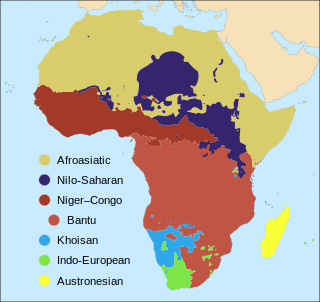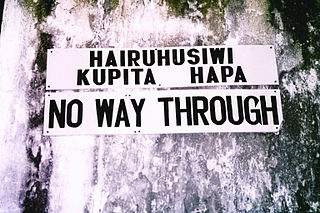
The Bantu languages are a language family of about 600 languages that are spoken by the Bantu peoples of Central, Southern, Eastern and Southeast Africa. They form the largest branch of the Southern Bantoid languages.

Swahili, also known by its local name Kiswahili, is a Bantu language originally spoken by the Swahili people, who are found primarily in Tanzania, Kenya and Mozambique. The number of current Swahili speakers, be they native or second-language speakers, is estimated to be over 200 million, with Tanzania known to have most of the native speakers.

Demographic features of the population of Tanzania include population density, ethnicity, education level, health of the populace, economic status, religious affiliations, and other aspects of the population.

The number of languages natively spoken in Africa is variously estimated at between 1,250 and 2,100, and by some counts at over 3,000. Nigeria alone has over 500 languages, one of the greatest concentrations of linguistic diversity in the world. The languages of Africa belong to many distinct language families, among which the largest are:

East Africa, also known as Eastern Africa or the East of Africa, is a region at the eastern edge of the African continent, distinguished by its geographical, historical, and cultural landscape. Defined in varying scopes, the region is recognized in the United Nations Statistics Division scheme as encompassing 18 sovereign states and 4 territories.
Comorian is the name given to a group of four Bantu languages spoken in the Comoro Islands, an archipelago in the southwestern Indian Ocean between Mozambique and Madagascar. It is named as one of the official languages of the Union of the Comoros in the Comorian constitution. Shimaore, one of the languages, is spoken on the disputed island of Mayotte, a French department claimed by Comoros.
The Swahili people comprise mainly Bantu, Afro-Arab and Comorian ethnic groups inhabiting the Swahili coast, an area encompassing the Zanzibar archipelago and mainland Tanzania's seaboard, littoral Kenya, northern Mozambique, the Comoros Islands and Northwest Madagascar.
The Akie are a Tanzanian ethnic and linguistic people living in south western Simanjiro District of Manyara Region. In 2000 the Akie population was counted at 5,268. The Akie, like other hunter-gatherer peoples in Kenya and Tanzania, are sometimes called by the derogatory and misleading term Dorobo or Wandorobo. The Akie were featured by Bruce Parry in the BBC series "Tribe". They live around 150 miles south east of Olduvai Gorge

Following Tanganyika's independence (1961) and unification with Zanzibar (1964), leading to the formation of the state of Tanzania, President Julius Nyerere emphasised a need to construct a national identity for the citizens of the new country. To achieve this, Nyerere provided what has been regarded by some commentators as one of the most successful cases of ethnic repression and identity transformation in Africa.
Kenya is a multilingual country.
The Segeju are a Bantu ethnolinguistic group mostly based in Tanzania's Tanga Region and Kenya's Kwale County. Most Segeju reside in the small coastal strip between the Tanzanian city of Tanga and the Kenyan-Tanzanian border. However, some Segeju have migrated to urban areas in other parts of Tanzania or Kenya, in hopes of better employment opportunities and quality of life. Segeju migration to urban areas often results in severance of community ties, leading to a lack of transmission of important cultural traditions and language.

The Rangi are a Bantu-speaking ethnic group of mixed Bantu and Cushitic heritage in the Dodoma Region of central Tanzania. In 2022, the Rangi population was estimated to number 880,000.
Gweno is a Bantu language spoken in the North Pare Mountains in the Kilimanjaro Region of Tanzania. The people known as the Gweno are a Chaga ethnic and linguistic group. Since the Chaga people are Bantu speakers, the adopted language contains dialects similar to that of the Kenyan language Kamba. Gweno shares about 54% to 56% of its vocabulary with other Chaga dialects and 46% with Taita dialects. However, a large percentage of its vocabulary is not seen in the other dialects. Also at the start of the 11th century, the Chaga people descended and migrated from the Bantu group in which they migrated to the foothills of mount Kilimanjaro. The Gweno language is today spoken mostly by older adults, with younger generations having shifted to Asu and Swahili. Ethnologue considers Gweno to be moribund; the language is not being passed down because children have not been exposed to Gweno since the 1970s. The generational shift from Gweno to either Asu or Swahili has certainly created shifts in dialect, however Gweno speakers do not see this as a threat.
The Alagwa are a Cushitic ethnic group mostly based in the Kondoa District of the Dodoma Region in central Tanzania, an area well known for rock art. Smaller numbers of Alagwa reside in the Hanang district of the Manyara Region in Tanzania, as well. They speak the Alagwa language as a mother tongue, which belongs to the South Cushitic branch of the Afro-Asiatic family. In 2022, the Alagwa population was estimated to number 52,816 individuals, and Mous (2016) estimates the number of speakers to be slightly over 10,000.
Digo (Chidigo) is a Bantu language spoken primarily along the East African coast between Mombasa and Tanga by the Digo people of Kenya and Tanzania. The ethnic Digo population has been estimated at around 360,000, the majority of whom are presumably speakers of the language. All adult speakers of Digo are bilingual in Swahili, East Africa's lingua franca. The two languages are closely related, and Digo also has much vocabulary borrowed from neighbouring Swahili dialects.
The Somali Bantus are a Bantu ethnic minority group in Somalia who primarily reside in the southern part of the country, primarily near the Jubba and Shabelle rivers. The Somali Bantus are descendants of enslaved peoples from various Bantu ethnic groups from Southeast Africa, particularly from Mozambique, Malawi, and Tanzania. The East African slave trade was not eliminated until the early parts of the 20th century.
Rangi or Langi is a Bantu language spoken by the Rangi people of Kondoa District in the Dodoma Region of Central Tanzania. Whilst the language is known as Rangi in English and Kirangi in the dominant Swahili spoken throughout the African Great Lakes, the self-referent term is Kilaangi.
Zaramo is a Niger-Congo language, formerly primary language of the Zaramo people of eastern Tanzania. Zaramo is also known as Zalamo, Kizaramo, Dzalamo, Zaramu, Saramo and, Myagatwa. The language is critically endangered. The ethnic population of the Zaramo people reaches about 200,000, yet there are only a few elderly speakers remaining.

Tanzania is a multilingual country. There are many languages spoken in the country, none of which is spoken natively by a majority or a large plurality of the population. Swahili and English, the latter of which was inherited from colonial rule, are widely spoken as lingua francas. They serve as working languages in the country, with Swahili being the official national language. There are more speakers of Swahili than of English in Tanzania.

The Bantu peoples are an ethnolinguistic grouping of approximately 400 distinct native African ethnic groups who speak Bantu languages. The languages are native to 24 countries spread over a vast area from Central Africa to Southeast Africa and into Southern Africa.










